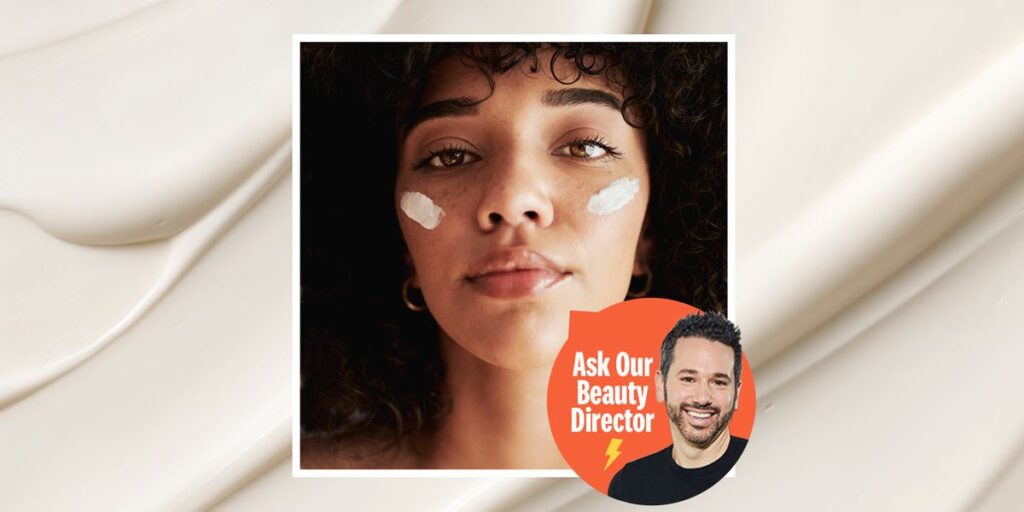In my experience as a beauty editor, there’s no topic shrouded in more mystery for more people than sunscreen. From how it works, to whether it expires, to what the SPF number really means, ya’ll have lots of questions. And that’s a good thing: You’d be hard pressed to find another skincare product that will give you more bang for your buck than the humble bottle of SPF. Not only can it help protect you from the skin mutations that can lead to cancers, but sunscreen has also been shown to reverse the visible signs of skin aging.
Yes, that $12 bottle of sunscreen you can pick up at the drugstore is one of the most powerful anti-aging products you can buy.
When it comes to which on you should add to your shopping cart, you’ve got options. From sticks to sprays to brush-on powders, there’s no shortage of sunscreens designed to address your specific wants and needs. Physical sunscreen is a specific type of product with certain ingredients that has recently been trending on TikTok. With more than 80 million views on the app, this tried-and-true product is trending again.
Here’s everything you’ll want to know.
What is physical sunscreen?
In the simplest terms, physical sunscreen refers to a product that uses one—or both—of the mineral UV filters approved by the U.S. Food & Drug Administration to be used in over-the-counter sunscreen products, says dermatologist Shari Sperling, MD, founder of Sperling Dermatology in New York and New Jersey. For this reason, you may also hear people refer to these products as “mineral” sunscreens as well—the terms can be used interchangeably.
So, what are the minerals used in a physical sunscreen? That’d be zinc oxide and titanium dioxide, which you’ll often find used together in a formula. You may also come across products that use zinc oxide on its own. That’s because while zinc oxide can protect broad spectrum protection against all waves of UVA and UVB light, titanium dioxide is less effective at shielding your skin from long-wave UVA without being heavy and thick on skin. “Titanium dioxide tends to be opaquer, and a bit harder to make cosmetically elegant on its own,” says dermatologist Dan Belkin, MD, of New York Dermatology Group in New York City.
How is physical sunscreen different from chemical sunscreen?
Chemical sunscreens use an entirely different set of non-mineral ingredients that are also approved by the FDA. These include things like avobenzone, homosalate, and octocrylene. These ingredients also work slightly differently, says dermatologist Divya Shokeen, MD, founder of Ocean Skin and Vein Institute, with several locations in California. “Physical sunscreens primarily work by creating a physical barrier that reflects and scatters UV rays away from the skin’s surface,” she explains. “Chemical filters absorb the sun’s rays, deflecting their damage by turning them into heat.”
Because of this, physical sunscreens work immediately upon application, while chemical products need twenty minutes to penetrate skin and convert UV radiation into heat, says Dr. Shokeen (though Dr. Belkin explains that we now know that mineral ingredients do also absorb some of the sun’s rays).
Is physical sunscreen safer than chemical sunscreen?
This is the big question—and one that doesn’t have a clear-cut answer. Currently, the FDA has divided the active ingredients approved for use in sunscreen into two categories: G.R.A.S.E. (generally recognized as safe and effective) and non-G.R.A.S.E. (within this category there are two subcategories—ingredients considered non-G.R.A.S.E. due to safety concerns and those that are non-G.R.A.S.E. because additional date is needed). As of now, both ingredients used in physical sunscreens are in the G.R.A.S.E. category and the most used chemical filters are considered non-G.R.A.S.E. because the FDA would like more information on their safety.
Research has shown that chemical filters can be absorbed into the human blood stream, which is why the FDA is seeking more data on their overall safety—what do these ingredients do once they’re in our bodies. But their classification as non-G.R.A.S.E. does not mean that the FDA has determined they pose any health risks and all the dermatologists I spoke to for this story consider them to be safe to use. As Dr. Belkin puts it: “When compared to the known carcinogenicity of UV radiation, I’d consider using chemical sunscreen to be fairly low risk even if there is a small amount of absorption.”
Is physical sunscreen better performing than chemical sunscreen?
Both products should be equally effective at protecting you from the sun’s damaging rays and the FDA has requirements regarding broad spectrum and water resistance testing, but there may be one compelling reason to choose physical sunscreen over chemical: “Physical sunscreens are generally considered safe and well-tolerated by most individuals, including those with sensitive skin,” says Dr. Shokeen. “They are less likely to cause skin irritation or allergies, making them suitable for various skin types.”
On the flipside, the idea of a thick whitish mask on your skin—an image that typically comes to mind when some people envision a physical or mineral sunscreen—is probably not very appealing, especially for those with darker skin. But it’s something formulators have been hard at work trying to correct. “Advances in formulation have led to improved texture and reduced whitening effect in modern physical sunscreens,” says Dr. Shokeen.
What should you look for in a physical sunscreen?
All my experts agree that while there are some basic bases that should be covered—an SPF of 30 or higher, a product that’s clearly labeled “broad spectrum,” one that’s water-resistant if you’ll be swimming or exercising outdoors—the most important factor is to find a product you’ll actually use. “Remember, the most important factor is consistent usage and proper application of sunscreen, regardless of whether it is physical or chemical,” says Dr. Shokeen. “Reapplication every two hours, or more frequently if exposed to water or excessive sweating, is crucial for adequate protection.”
Dr. Belkin would also prefer you to pick up a product that’s also labeled “non-nano,” meaning the mineral particles have not been micronized, which is sometimes done to make a product spread more easily and appear sheer on skin. “Sometimes, the micronization process can affect how broad spectrum a product is,” he says. To help in your search for the right physical sunscreen for you, I’ve put some of my favorite picks below. Happy shopping—and happy summer.


